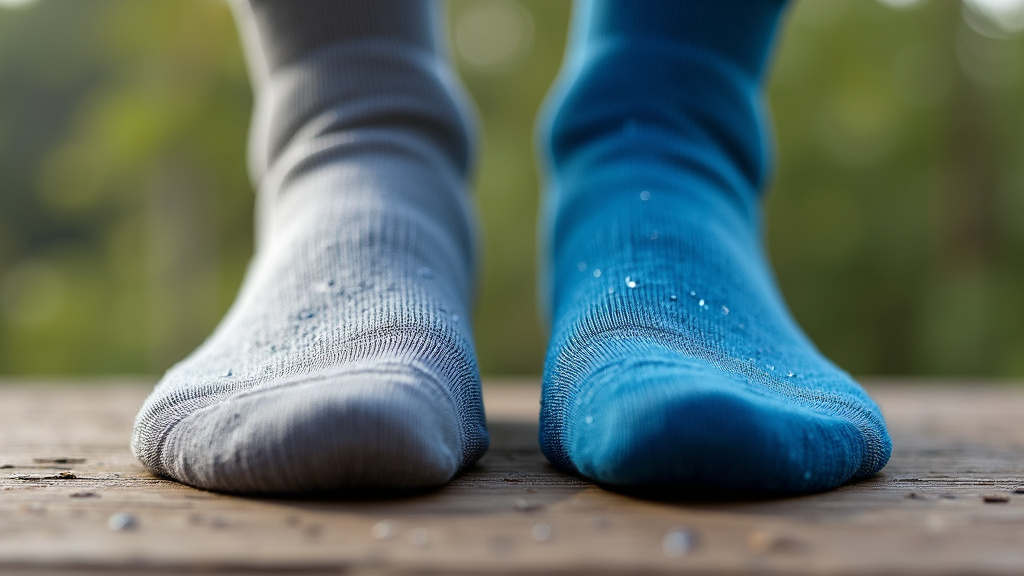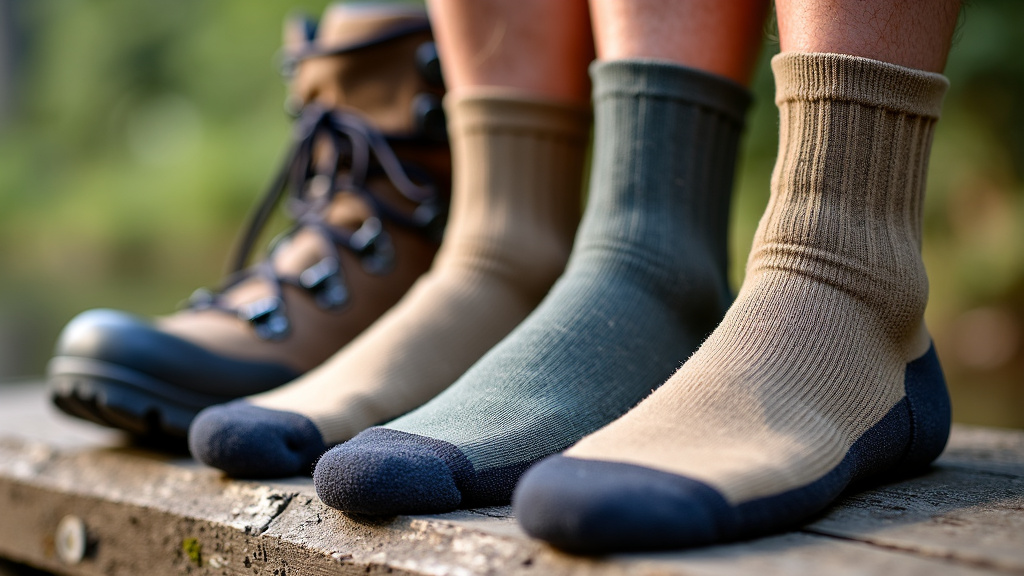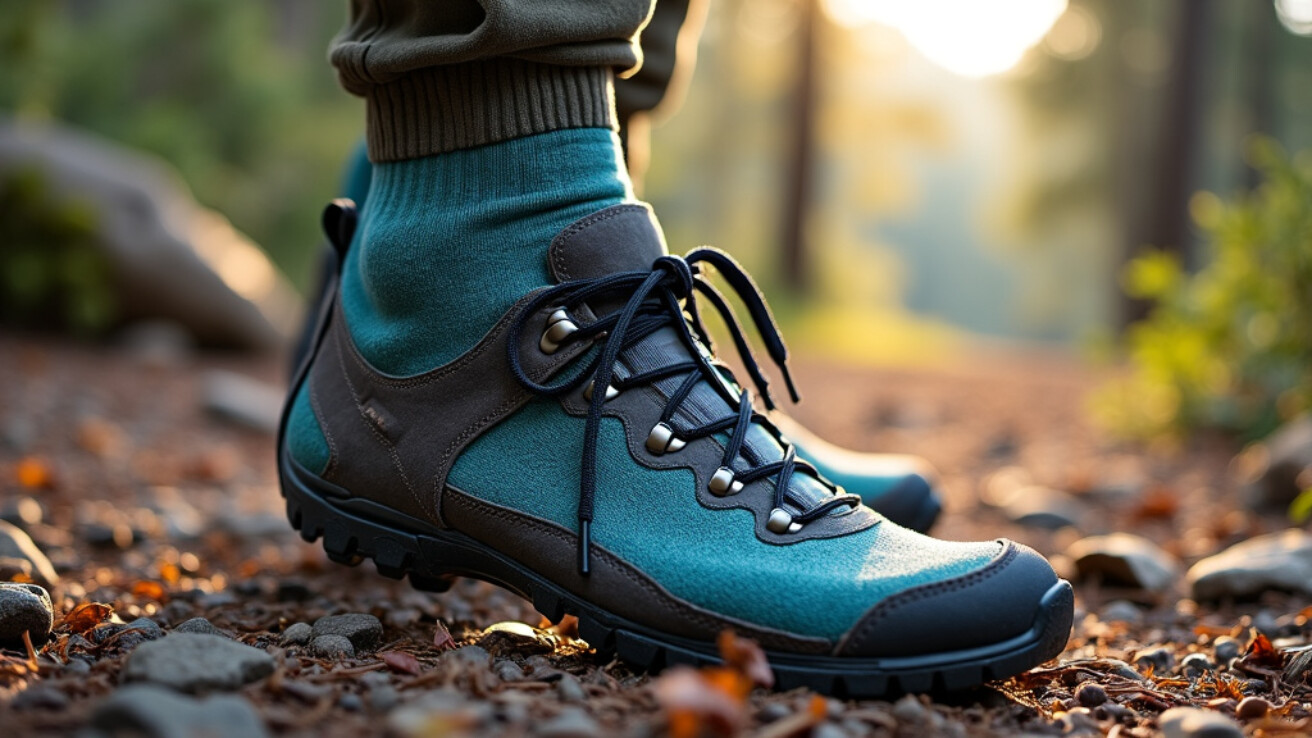Finding the perfect hiking socks was a game-changer for me – and I bet it will be for you too. After countless miles of blisters and discomfort on the trail, I discovered that the right pair of socks is just as crucial as your hiking boots for an enjoyable outdoor experience.
I used to think any old cotton socks would do, but I couldn’t have been more wrong. The difference between basic cotton socks and proper hiking socks is striking when you’re putting in serious miles on challenging terrain. Quality hiking socks provide essential moisture-wicking, cushioning in all the right places, and blister prevention that can make or break your hiking adventure.
Whether you’re planning a challenging backpacking trip or just getting into day hiking, understanding the key elements of hiking socks will help protect your feet and enhance your outdoor experience. We’ll explore how materials like merino wool outperform basic cotton, the importance of finding the right cushioning level for your activities, and how proper fit prevents those dreaded hot spots and blisters.
I’ve tested dozens of hiking socks across varied terrain and weather conditions, and I’m excited to share what I’ve learned about choosing the best options for different hiking styles and preferences. Let’s explore everything you need to know about selecting hiking socks that will keep your feet happy on the trail.
Understanding Hiking Sock Materials

The right hiking sock material can make the difference between a blissful trek and a blister-filled nightmare. Modern hiking socks primarily use two main materials: merino wool and synthetics like polyester and nylon.
Merino wool serves as nature’s technical fiber, offering exceptional temperature regulation in both hot and cold conditions. Its unique fiber structure absorbs up to 30% of its weight in moisture while maintaining insulating properties, making it ideal for long hikes in variable conditions.
Synthetic materials like polyester and nylon offer distinct advantages. These engineered fibers excel in quick-drying performance and durability. As highlighted by Wildland Trekking’s gear experts, synthetic hiking socks typically last twice as long as pure merino wool options.
In terms of moisture management, each material handles sweat differently. Merino wool absorbs moisture into its fibers and slowly releases it through evaporation, while synthetics actively wick moisture away from your skin to the outer surface of the sock.
Odor control is where merino wool truly excels. Its natural antimicrobial properties prevent the growth of odor-causing bacteria, keeping your feet fresher for longer. Synthetic materials, while excellent at wicking moisture, tend to develop odors more quickly during extended wear.
| Feature | Merino Wool | Synthetic Materials |
|---|---|---|
| Moisture Management | Absorbs moisture, releases it slowly | Wicks moisture to the outer surface |
| Odor Control | Natural antimicrobial properties, resists odor | More prone to developing odors |
| Temperature Regulation | Excellent in both hot and cold conditions | Good, but less effective in variable conditions |
| Durability | Less durable, prone to pilling | More durable, resists wear |
| Drying Time | Slower to dry | Quick drying |
| Cost | Generally more expensive | Less expensive |
Most modern hiking socks combine both materials to maximize benefits. A blend of 40-70% merino wool with synthetic fibers creates an optimal balance of comfort, durability, and moisture management. The merino provides temperature regulation and odor control, while the synthetics add durability and help maintain the sock’s shape.
For summer hiking, consider lightweight socks with a higher percentage of synthetic materials for maximum breathability. In colder conditions, socks with a higher merino wool content (50-80%) provide better insulation while still managing moisture effectively.
Understanding these material properties helps you choose the right socks for your specific hiking needs, whether you’re planning a short day hike or a challenging multi-day trek through varying weather conditions.
Choosing the Right Cushioning Level
Sock cushioning plays a vital role in hiking comfort that many hikers overlook. I’ve learned through thousands of trail miles that the right amount of cushioning can make the difference between an enjoyable hike and a blister-filled ordeal.
Let’s explore the four main cushioning levels you’ll encounter and help you find your perfect match. Having tested dozens of socks across varied terrain, I can tell you that no single cushioning level works for everyone.
Ultralight Cushioning
Think of ultralight socks as your hot-weather specialists. These barely-there socks use the thinnest fabric throughout, making them incredibly breathable for scorching summer hikes. They’re perfect when your feet tend to swell in the heat.
I particularly love ultralight cushioning for desert hiking and fast-paced adventures where excess heat buildup is a concern. With minimal padding, these socks are best suited for well-maintained trails rather than technical terrain.
The trade-off with ultralight cushioning is durability – you might find yourself replacing these more frequently than their thicker counterparts. However, the superb breathability often makes this worthwhile for warm-weather hiking.
Light Cushioning
Light cushioned socks strike an excellent balance for three-season hiking. They offer strategic padding in high-impact areas like the heel and ball of the foot while maintaining good breathability throughout.
I’ve found light cushioning to be incredibly versatile, working well for both day hikes and longer backpacking trips in moderate conditions. They provide just enough protection without overwhelming your feet with excess warmth.
These socks excel when paired with trail runners or lightweight hiking shoes. The targeted cushioning helps prevent hot spots while still allowing your feet to breathe.
Medium Cushioning
For those carrying heavier packs or hiking rougher terrain, medium cushioning offers substantial protection. The increased padding throughout the sock helps absorb impact and prevent fatigue on long days.
After extensive testing in various conditions, I’ve found medium cushioning to be the sweet spot for most backpackers. They provide enough padding for comfort without significantly impacting shoe fit or breathability.
Be aware that the extra material means these socks will retain more heat than lighter options. However, this can be beneficial in cooler conditions or when you need additional protection.
Heavy Cushioning
Reserved for the most demanding conditions, heavily cushioned socks are the tanks of the sock world. They excel in cold weather hiking, mountaineering, and when maximum impact protection is needed.
The substantial padding in these socks helps prevent blisters during long descents and provides crucial insulation in freezing conditions. Remember that all this cushioning comes at the cost of breathability.
If you’re considering heavyweight socks, ensure your boots have enough volume to accommodate the extra thickness. I’ve learned the hard way that cramming thick socks into snug boots is a recipe for discomfort.
Choosing the right cushioning level ultimately comes down to understanding your specific needs and hiking style. Consider factors like typical weather conditions, terrain difficulty, and your personal temperature regulation when making your selection.
Finding the Perfect Fit: Sock Height and Sizing

I’ve learned through countless miles on the trail that sock fit can make or break your hiking experience. Nothing ruins an adventure faster than painful blisters from ill-fitting socks.
Let me guide you through the essential elements of finding your perfect hiking sock fit, drawing from both my experience and expert recommendations from seasoned hikers and manufacturers.
Your hiking socks should feel like a second skin – snug but never constraining. According to REI’s footwear specialists, if your socks are too big, they can wrinkle and cause blisters; too small, and they’ll create uncomfortable pressure points.
Choosing the Right Sock Height
Sock height serves a crucial purpose – protecting your feet from your hiking footwear. The general rule is that your socks should extend at least 1-2 inches above your boot height to prevent painful rubbing.
For low-cut hiking shoes, ankle-length socks provide adequate protection while keeping your feet cool. They’re ideal for warm-weather day hikes when you want minimal coverage.
Crew-length socks are the most versatile option and my personal go-to for most hiking situations. They rise 6-8 inches above your ankle, offering excellent protection against boot friction and trail debris.
For mountaineering or cold-weather hiking, knee-high socks provide maximum protection and warmth. They’re essential when wearing tall boots or traversing snowy terrain.
Finding Your Perfect Size
Avoid the common mistake of choosing socks based solely on your shoe size. Your feet can swell up to a full size during long hikes, so account for this when selecting your size.
When trying on hiking socks, they should feel snug but not restrictive. The heel cup should align perfectly with your heel, and you should be able to wiggle your toes freely.
A proper fit means no bunching in the toe box or slipping at the heel. If you’re between sizes, I recommend sizing down slightly – the socks will stretch with wear, but excess material never disappears.
Special Sizing Considerations
Remember that different brands may size their socks differently. Some brands like Darn Tough offer size-specific fits, while others use broader size ranges.
For multi-day hikes, consider going up one size in at least one pair of socks. Your feet will naturally swell more over consecutive days of hiking, and having a slightly larger option can provide welcome relief.
When in doubt, visit an outdoor specialty store where you can try on socks with your hiking boots. This ensures you get the perfect combination of sock and boot fit for blister-free adventures.
Care and Maintenance of Hiking Socks
Your hiking socks represent a significant investment in comfort and performance on the trail. Through years of experience, I’ve learned that proper care can dramatically extend their lifespan while maintaining their crucial moisture-wicking and cushioning properties.
Quality hiking socks aren’t cheap, but with the right care routine, you can make them last significantly longer and perform better. I’ve developed these best practices after countless miles on the trail and many prematurely worn-out socks.
Washing Your Hiking Socks
First, always turn your socks inside out before washing. This allows the washing machine to better clean the areas that contact your feet while protecting the outer fabric. This simple step makes a significant difference.
When it comes to detergent, less is more. Use a gentle, wool-specific detergent and avoid harsh chemicals like bleach or fabric softeners that can damage the technical fibers.
I recommend washing your hiking socks in cold or lukewarm water on a gentle cycle. Hot water can break down the elastic and damage moisture-wicking properties. For delicate merino wool socks, hand washing is even better.
Proper Drying Techniques
Never throw your hiking socks in the dryer on high heat. High temperatures can shrink and damage the specialized fibers that make these socks perform so well.
Instead, lay your socks flat to air dry away from direct sunlight. If you must use a dryer, use the lowest heat setting and remove them while slightly damp to finish air drying. This preserves the sock’s fit and technical properties.
When drying socks on the trail, avoid placing them directly on hot rocks or near the campfire. The intense heat can damage the fibers. Instead, hang them from your pack while hiking or use a clothesline at camp.
Storage and Care Between Hikes
Store your hiking socks in a cool, dry place away from direct sunlight. I use a dedicated drawer with cedar blocks to naturally repel moths and absorb moisture. This helps prevent degradation of the materials over time.
Don’t ball or stuff your socks when storing them – this can stretch out the elastic. Instead, fold them loosely or lay them flat. This maintains their shape and extends their lifespan.
When to Replace Your Hiking Socks
Pay attention to signs of wear like thin spots, holes, or loss of elasticity. If your socks no longer stay in place or provide adequate cushioning, it’s time for a replacement. Don’t wait until they completely fail – worn-out socks can lead to blisters and discomfort.
In my experience, quality hiking socks typically last 200-400 miles of trail use when properly cared for. However, this varies based on conditions, care practices, and how hard you are on your gear.
Stepping Into Comfort on the Trail

After spending countless miles on rugged trails and remote wilderness paths, I’ve learned that quality hiking socks are far more than just another piece of gear – they’re an essential investment in your outdoor comfort and enjoyment. The right pair can mean the difference between an exhilarating summit celebration and a painful trudge back to the trailhead.
Through extensive testing of various hiking socks, I’ve discovered that excellence lies in the details. Premium merino wool blends offer exceptional moisture-wicking and temperature regulation, while strategic cushioning in high-impact areas prevents hot spots and blisters. The precise fit around the arch and ankle provides crucial stability throughout your journey.
From my experience, investing in quality socks from reputable manufacturers pays dividends in durability and performance. While they may cost more upfront, the comfort and protection they provide make them worth every penny. I’ve witnessed many hikers learn this lesson the hard way, ending up with blistered feet and compromised adventures.
Your choice in hiking socks can transform your trail experience. Whether you’re planning a casual day hike or a challenging backcountry expedition, select socks that match your specific needs in cushioning, height, and seasonal appropriateness. Your feet will thank you as you confidently cover miles with dry, comfortable, and well-protected steps.







